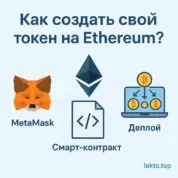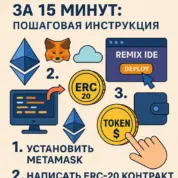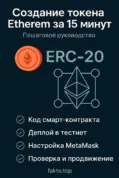Launch Your Own Ethereum Token in 15 Minutes — No Coding Degree, No BS
Create Your Own Ethereum Token: A 15-Minute Step-by-Step Guide
Launching your own token on Ethereum isn’t just geeky fun — it’s your first real move toward building a legit crypto project. In this guide, we’ll show you how to create an ERC-20 token in just 15 minutes using beginner-friendly tools and minimal coding skills. No PhD required.
What’s an Ethereum Token and Why Bother Making One?
An Ethereum token is a digital asset that lives on the Ethereum blockchain. It can represent anything — currency, project shares, voting rights, or even a one-of-a-kind collectible. The most popular standards are ERC-20 (utility tokens) and ERC-721 (NFTs).

Why Create Your Own Token?
- Raise funds via ICOs or airdrops (yes, free tokens still work)
- Tokenize your biz model or digital assets
- Join the DeFi, DAO, and Web3 party
How to Create an Ethereum Token: Prep & Tools
Before you start minting magic, here’s what you’ll need:
1. Install MetaMask — Your Ethereum Wallet Sidekick
MetaMask is a browser extension that lets you manage your wallet and sign transactions. Think of it as your crypto passport. Setup guide here.
2. Get Test ETH via Rinkeby or Sepolia Faucet
You’ll need test ETH to play around safely. Grab some from the Sepolia Faucet. No real money lost if you mess up.
3. Use Remix IDE — Your Smart Contract Playground
Remix is a web-based IDE for writing, compiling, and deploying smart contracts. Head to Remix IDE and get comfy.
ERC-20 Token: Smart Contract Basics
What’s ERC-20 and Why It Matters
ERC-20 is a set of rules your token must follow to play nice with wallets, exchanges, and dApps. Key functions include: transfer, balanceOf, approve, transferFrom.
Sample ERC-20 Contract
// SPDX-License-Identifier: MIT
pragma solidity ^0.8.0;
import "@openzeppelin/contracts/token/ERC20/ERC20.sol";
contract MyToken is ERC20 {
constructor(uint256 initialSupply) ERC20("MyToken", "MTK") {
_mint(msg.sender, initialSupply * (10 ** decimals()));
}
}
This contract creates a token called MyToken with the ticker MTK. When deployed, it mints the specified amount to your wallet. Boom — you’re officially a token creator.

Deploying Your Token via Remix IDE
Step 1: Paste the Contract Code into Remix
Create a new file called MyToken.sol and paste the code above. Make sure OpenZeppelin is imported correctly.
Step 2: Compile the Contract
Go to “Solidity Compiler,” select version 0.8.0, and hit “Compile.” No errors? You’re golden.
Step 3: Deploy to Ethereum Testnet
Head to “Deploy & Run Transactions,” choose “Injected Web3,” connect MetaMask, and select Sepolia network. Enter token amount (e.g., 1000000) and click “Deploy.”
Token Check: Make Sure It Actually Works
How to View Your Token Balance in MetaMask
Manually add the token using the contract address. Your shiny new balance should pop up.
Using Your Token in DeFi & DApps
Your token can now be used in smart contracts, exchanges, DAOs, and other Web3 apps. Curious how DeFi stacks up against TradFi? Check our deep dive.
Token Creation Tips: Stay Safe Out There
Code Review & Smart Contract Audit
Before going live on mainnet, audit your contract. Use tools like MythX, Slither, or hire pros. Trust us — one bug and your token could be toast.
Access Control & Vulnerability Protection
Use onlyOwner modifiers and the Ownable library to lock down permissions. No one wants a rogue dev minting infinite tokens.
Token Launch: Registration & Promotion
Add Your Token to Etherscan
After deployment, register your token on Etherscan with its name, ticker, and decimals. It’s like getting verified on crypto Twitter.

Promote Your Token: ICO, Airdrop, Listings
- Run an airdrop for active users — free tokens = buzz
- Launch an ICO or token sale via platforms like Launchpad
- List your token on aggregators: CoinGecko, CoinMarketCap
Once live, you can integrate your token into DeFi protocols like staking. Curious how staking works with USDT? Read our staking guide.
Conclusion: Creating an Ethereum Token Is Easier Than You Think
Building your own token is your ticket into Web3. With Remix, MetaMask, and OpenZeppelin, you can launch a legit digital asset in under 15 minutes. Just know your architecture, stay safe, and promote smart.
Want to go deeper? Add burn/freeze functions, governance features, or even pivot to NFTs with ERC-721. It all depends on your project goals.
Also, understanding stablecoins helps. Check out DAI — a DeFi staple for stable value.
Creating a token isn’t just technical — it’s joining a fast-moving ecosystem. Learn more about Ethereum’s growth in our full breakdown.
Why Launch a Token on Ethereum?
Ethereum gives you access to a powerful, flexible ecosystem that powers thousands of successful crypto projects. It’s not just a blockchain — it’s a platform for building dApps, DeFi protocols, NFTs, and DAOs.
Your token can be a project currency, equity share, voting tool, reward system, or access pass. Perfect for startups raising capital via ICOs or companies digitizing assets. Tokens also help build sticky user engagement — staking, farming, gamification, you name it.
Ethereum offers top-tier security, transparency, and decentralization — making it the go-to for token launches. Even if you’re not building the next unicorn, creating your own token is a killer way to learn Web3, test ideas, and get hands-on blockchain experience.
Already in DeFi or NFTs? Your own token might be the next logical step in your digital strategy.